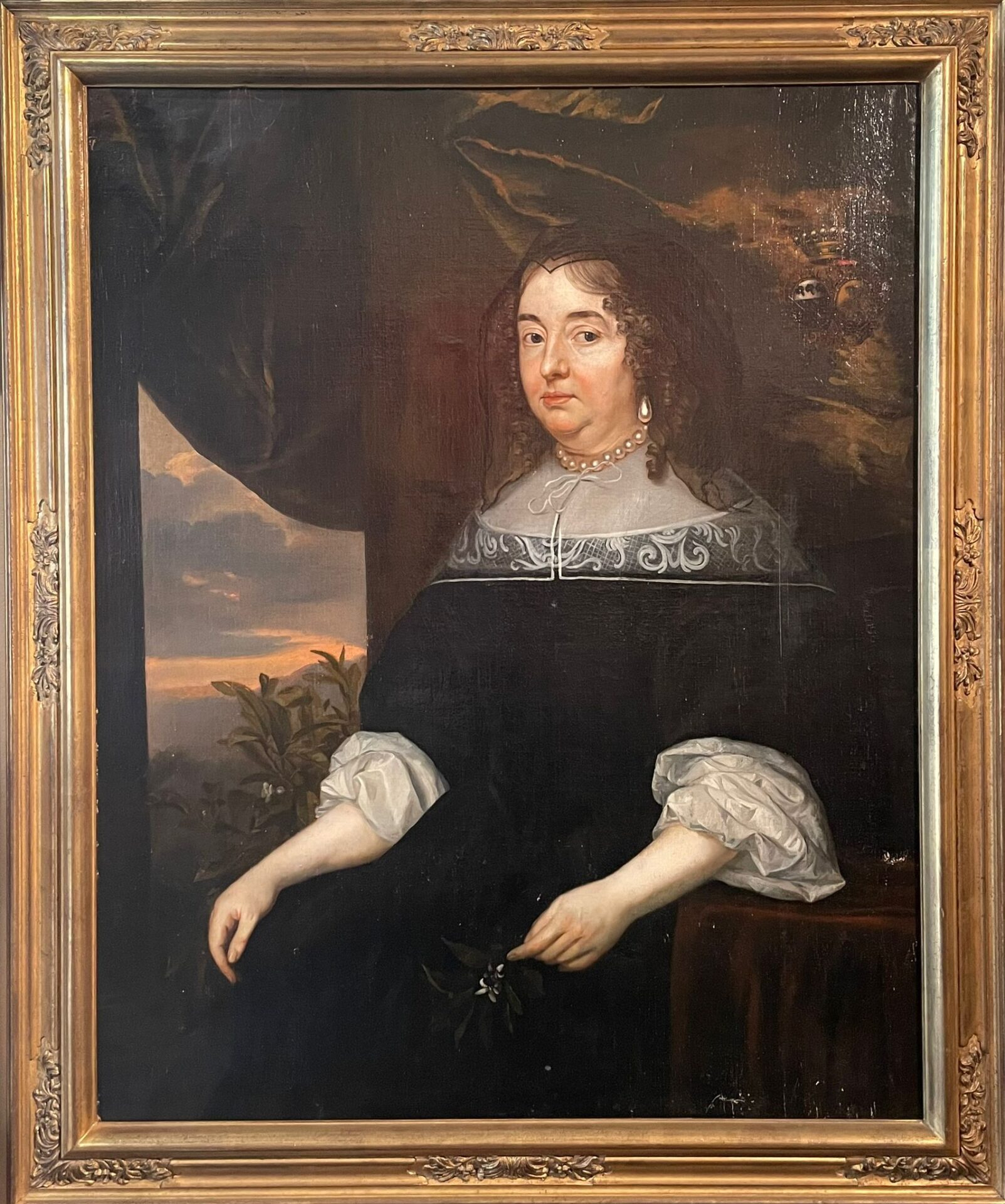Amalia Van Solms portrait, 17th century, Pendant unknown, both portraits have the same family coat of arms
Research has shown that a single copy is owned by :
- Stichting Historische Verzamelingen van het Huis Oranje-Nassau, The Hague
- Palace Het Loo National Museum, Apeldoorn, inv. / cat. nr PL 236
on loan from the historical collections foundation of the House of Orange-Nassau
Amalia of Solms-Braunfels (Castle Braunfels, 31 August 1602 — The Hague, 8 september 1675), Countess of Braunfels, was the wife of Prince Frederick Henry of Orange.
Amalia of Solms-Braunfels was born on 31 August 1602, the daughter of Johan Albrecht I van Solms-Braunfels (the eldest son of Elisabeth of Nassau, a sister of William of Orange) and Agnes of Sayn-Wittgenstein. She spent her childhood on the Castle Braunfels to the Lahn. She was a granddaughter of Koenraad Van Solms (1540-1592) and Elisabeth of Nassau (1542-1603 on his father's side and Louis I of Sayn-Wittgenstein (1532-1605) and Elisabeth of Solms-Laubach (1549-1599) on his mother's side.
At the age of 18, she was court Lady from Elizabeth Stuart, wife of Frederick V of the Palatinate, the’ Winter King ' of Bohemia (and full cousin of the stadtholder), to The Hague. Here she met Frederik Hendrik, whose great-niece she was. She acted April 4 1625 with him in marriage. Frederik Hendrik's half-brother Maurits had asked him this on his deathbed, otherwise he would not inherit from Maurits.
From their marriage, nine children were born, four of whom did not reach adulthood:
- William II of Orange (May 27 1626 – 6 november 1650) (governor) married to Maria Stuart
- Louise Henriëtte de Nassau (December 7 1627 – June 18 1667), married to elector Frederick William I of Brandenburg
- Henriëtte Amalia of Nassau (October 26 1628 – December 1628)
- Elisabeth of Nassau (4 August 1630died the same day)
- Isabella Charlotte of Nassau (April 28 1632 – April 1642)
- Albertine Agnes of Nassau (April 9 1634 – May 24 1696). married William Frederick of Nassau-Dietz
- Henriëtte Catharina van Nassau (10 February 1637 – 3 november 1708), married Johan George II van Anhalt-Dessau
- Henry Louis of Nassau (30 november 1639 – 29 december 1639)
- Maria of Nassau (5 september 1642 – 20 March 1688), married Louis Henry Maurice of Palatinate-Simmern (was the son of Louis Philippe of Palatinate-Simmern and of Maria Eleonore of Brandenburg)
When Frederick Henry became stadtholder after the death of his half-brother Prince Maurice, he was able to greatly expand his influence on policy. With this, Amalia's influence also grew.
Under Frederick Henry and Amalia, the ceremonial in the court life of The Hague increased considerably. The construction of a number of palaces, including Huis Honselaarsdijk, Rijswijk Palace, Huis ten Bosch significant renovations to the Old Court in the Noordeinde, the castle of Neighbour and has Court of Solms in Oirschot, followed. Amalia was the driving force behind the marriage of her eldest daughter Louise Henriëtte to the elector of Brandenburg and her son William II with Maria Henriëtte Stuart. After the death of her son, she took custody of her grandson William III by itself.
After the death of her husband in 1649, King Philip IV of Spain the territory of Turnhout off to her. As Lady of Turnhout, she had an important influence on the history of Baarle and the enclave history from Baarle.
Her remains were buried in the Crypt of Orange-Nassau in the Nieuwe Kerk to Delft.
In the former stadtholder's Palace on the Courtyard in The Hague, the current building of the First Chamber of States General, there is a gallery named after Amalia Van Solms. In the Amalia Van Solmsgalerij there is a series of seventeenth-century portraits of women from the court of Amalia Van Solms.
In 1632 the new flagship from the Admiralty of Rotterdam named after her with the name Aemilia. This name was most commonly used but also Princess Amalia or Amilia occurred.
according to management data Palace Het Loo by Van Kretschmar’ without a doubt ' attributed to Jan Mijtens
Source: to Johannes Mijtens (rkd.nl).
